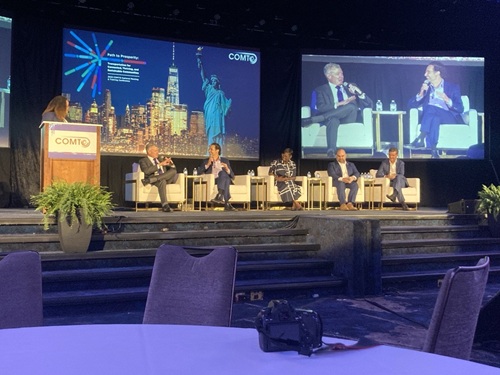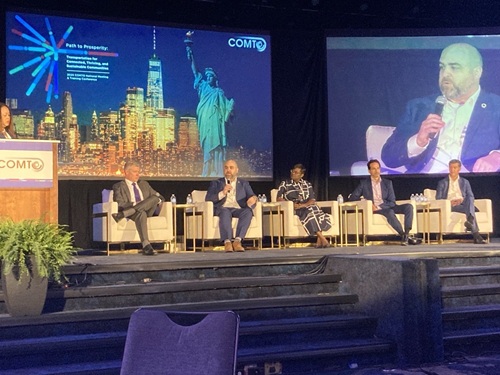At the 54th Conference of Minority Transportation Officials (COMTO) national meeting in New York City on July 14, leadership from the American Association of State Highway and Transportation Officials shared insights on everything from surface transportation funding reauthorization to how transportation serves as a critical “quality of life” linchpin for communities nationwide.
[Above photo by AASHTO]
As part of a panel of state, local, and city transportation stakeholders, Garrett Eucalitto – commissioner of the Connecticut Department of Transportation and AASHTO’s 2024-2025 president, and Jim Tymon – AASHTO’s executive director – explained to COMTO attendees how the funding levels within the Infrastructure Investment and Jobs Act of 2021 should become the “baseline” for surface transportation funding moving forward, instead of a “one-in-a-lifetime” investment.
Both noted that IIJA funding provided states with the flexibility that they need to innovate and shape the future of transportation while also investing in maintenance nationwide. While the IIJA gave a 20 percent “bump up” in funding for transportation, they said inflation and other factors ate up much of that increase, leaving the nation’s transportation infrastructure in very real funding trouble.

That’s why the IIJA’s higher levels of funding need to be maintained in the next surface transportation reauthorization bill, which needs to replace the IIJA when the IIJA expires September 2026, the stressed.
Both pointed to AASHTO’s six policy resolutions, approved and adopted by the organization’s board of directors at its 2025 Spring Meeting in Hartford, CT, this May; resolutions that outline how formula funds – distributed directly to states – have proven “time and again” to be the most efficient way to quickly translate dollars into projects that benefit their communities.
“While AASHTO believes there is a certain place for discretionary grants, formula funding enables funds to be distributed to states in a stable and predictable manner and allows states to efficiently deliver projects identified and prioritized through a statewide and metropolitan planning process,” Tymon noted.
He added that “improving the quality of life” should be the performance measure for all surface transportation funding.
“At the end of the day that should be the measure: How are we taking these investments in transportation and improving the quality of life across all the communities that we serve,” he stressed. “I think that’s been a priority for us at AASHTO for a while and I think it has been a priority for all the transportation stakeholders out there.”
Tymon emphasized that stronger partnerships within the transportation community – even among groups with different transportation perspectives – will be instrumental to making such improvements happen at a greater pace.
Eucalitto expanded on that view by noting that “thriving connected communities” should be places where it is “easy to get around” and “you don’t need to own a car if you don’t want to” to get from place to place.
“That’s something we’ve been trying to focus on in Connecticut,” he explained. “We’ve been increasing service levels in our transit system in Connecticut to try and alleviate that burden [of car ownership].”
An even bigger issue, though, is a “call to action” among transportation stakeholders to spread the message about the importance of infrastructure.
“We need to explain how it is critical to the daily life of every single human being on our planet,” Eucalitto said. “Even if you never leave your home, if you stay in your home 24/7, you are still impacted by the work every state and city DOT performs every single day. We are providing the mechanism to get what you need in your home; your foodstuffs, your furniture. The people that go fix our electric and water systems; they use our transportation system to do their jobs. So we are the critical link in human society and we need to make sure we spread that message.”
 Nation
Nation
The Stream by AASHTO: Electrified Roadway Testing
December 5, 2025 Nation
Nation

